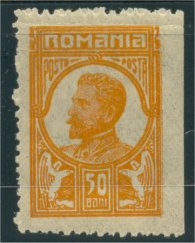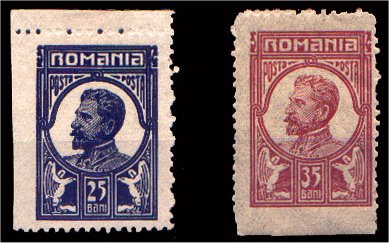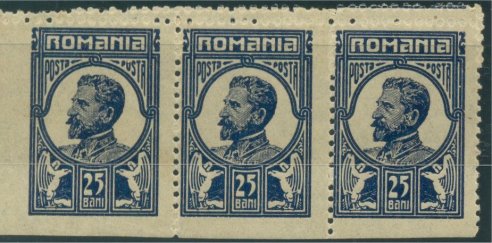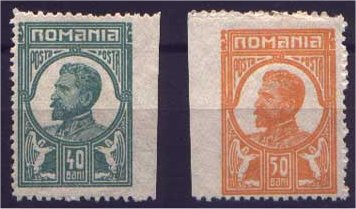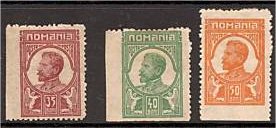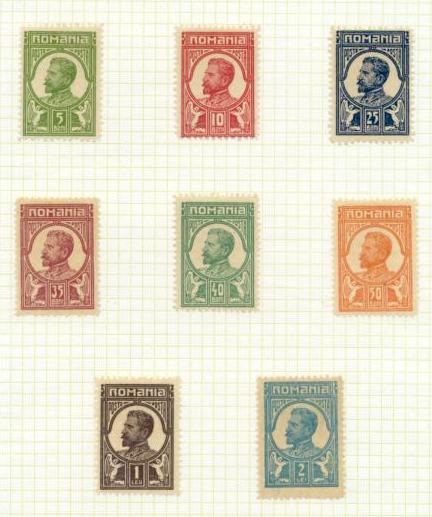
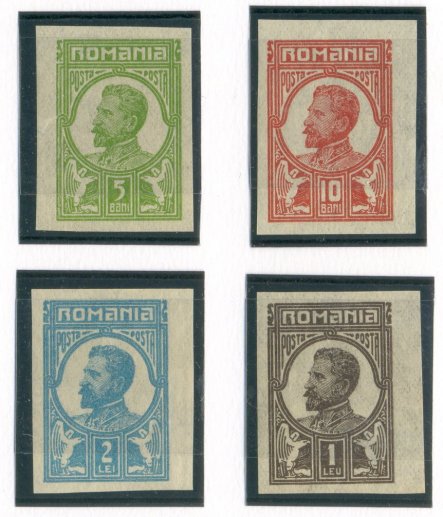


| Imperforated in blocks of 10 with inscription : HUD TIP AMERIK Hudojniki Tipografia Amerika (American Artistic printers) |
25B , 35B, 50B (courtesy: Bob Palmer) |
| A THEORY It would appear that the stamps were printed, as the Russian stamps of that period, in separated panes of 25 with 4 panes per sheet. The paper used is also similar to that found on Russian and Ukrainian stamps of this period. Some sources say that an initial order of 20,000 sets (what ever a set may be) was supplied to Iasi where they were ordered to be destroyed. Obviously all were not destroyed. In fact 6 stamps had enough of them preserved to make them relatively common. Theses are the 25 Bani, 35 Bani, 40 Bani and 50 Bani with the Dumitriu Head and two Timbru de Ajutor values - 5 Bani and 10 Bani. There are 4 other Dumitriu Head values: 5 Bani, 10 Bani, 1 Leu and 2 Lei are however considerably scarcer. It is my belief that the stamps were all delivered from Russia in an imperforated state and that the perforations were added later. How do I come to this conclusion? 1. Examination of Russian sheets indicate that the Russians were very good at perforating their sheets. Well perforated examples of the Moscow Issue are hard to find. 2. All imperforated copies of the 4 scarcer Dumitriu Head values are marginal copies. Imperforated stamps from the centre of the pane of 25 can't be found, apart that is from the 4 common Dumitriu Head values, where they exist in abundance. 3. The perforating method used 11.4x11.4 appears to have been incapable of perforating the top, bottom or either left or right margin. 4. The Romanian government evacuated to Iasi had decided for whatever reason [mostly likely was their distrust for the political instability in Russia] to destroy the stamps. So why would they waste precious resources, assuming they even existed, to perforate stamps destined for destruction. 5. If the Romanian authorities did not perforate the stamps who did? Maybe a philatelic "entrepreneur" realised that if you perforated the stamps you could sell two sets - 1 perforated and 1 imperforated - to collectors and at the same time reduced the number of imperforated stamps remaining and thus increasing their rarity value still further. The optimum way of achieving equal numbers of both perforated and imperforated copies is to leave the outsides of the pane imperforated. So by careful trimming of the stamps 16 imperforated but single marginal copies still existed whilst 9 fully perforated central sheet copies had been created. The following table illustrates the perforation lines and how they would effect each of the 25 stamps making up the pane. Those which would be partially perforated, and could be trimmed to marginal imperforated copies are "i", whilst the fully perforated are "p". In addition to being able to sell two sets of stamps, it would also be possible to sell perforation "errors" (ie partially perforated stamps) from the 4 common values, no doubt at a premium price.
This ratio also roughly correlates to the stamps I have encountered on
the 4 scarce Dumitriu Head values. |

